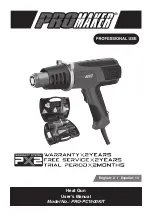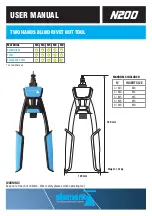
-18-
- 2 turns into the spacer blocks 12 using the open-
ended spanner (width across flats 8). Pull the spacer
blocks with blade and blade carrier 9 laterally from
the planing shaft.
Clean all parts and the blade chamber inside the
planing shaft.
Always reverse both blades or fit new blades. Pay
attention that the blades are fitted on the pins in the
spacer block first and only then the blade carriers.
Afterwards, insert the blades including the carrier
system laterally into the planing shaft and pay
attention that blade carrier and blades do not laterally
protrude beyond the shaft body. First only lightly, then
firmly tighten the clamping screws from the centre
outwards using the open-ended spanner (width
across flats 8) included in the supply (8.4 Nm). Tilt the
cover back again and tighten the screws. The planing
shaft has been preset at the factory. An adjustment of
the fitted blades is therefore not necessary and may
not be carried out, as otherwise the permissible
projection of the blades beyond the shaft body may
be exceeded.
5 Operation
5.1 Initial operation
Personnel entrusted to work with the machine must
be made aware of the operating instructions, calling
particular
attention
to
the
chapter
"Safety
instructions".
5.2 Switching on and off
Before switching on, pay attention that the machine's
planing shaft does not rest on the support or on the
workpiece. For this purpose, lift the carpenter's plane
with both hands by the handles 1 and 4 (Fig. 4).
Switching on:
First unlock the switch-on lock
by pressing the locking lever 15 (Fig. 4) to the
front. Then actuate the control lever 2. As this is
a switch without locking device, the machine will
only run for as long as this switch is pressed.
The built-in electronic system provides for jerk-free
acceleration when the machine is switched on and
under load readjusts the speed to the fixed setting.
In addition, this electronic system adjusts the motor
down in case of overload, i.e. the planing shaft will
stop. The load on the machine must then be reduced
until the planing shaft has reached its full speed. After
that, continue to plane at reduced feed speed.
Switching off:
To switch off, release the switch
trigger 2. The switch-on lock automatically takes
effect again and secures the machine against
accidental switch-on.
On switching off the machine, the automatic brake
takes effect simultaneously. This shortens the slowing
time of the machine to approx. 1 - 3 seconds.
5.3 Depth of cut adjustment
The chip removal can be set to between 0 and 4 mm
(0 – 3/16 in.). This is done with the handle 5 (Fig. 4)
for depth of cut adjustment. The set planing depth
can be read off scale 6.
During normal operation, the chip removal should
remain restricted to approx. 3 mm (1/8 in.). To avoid
overloading the motor, the maximum chip removal
should only be used in extreme cases.
5.4 Work instructions
Thanks to its balanced weight distribution, the
carpenter's plane has a good grip. It can be guided
using the handles 1 and 4 (Fig. 4).
For planing, the machine's front contact area is
placed onto the workpiece such that the planing shaft
does not engage. After switching on and as soon as
the planing shaft has reached its full speed, the
carpenter's plane is guided over the timber applying
an even pressure. An even feed results in a regular
planing pattern and reduces the strain on the
machine.
When the carpenter's plane is overloaded, the speed
of the planing shaft drops. It is then necessary to wait
until the planing shaft has reached its full speed
again. Afterwards, it is possible to continue working
with reduced feed.
When working with a full planing width, the lever with
guide roller 7 is tilted downwards and tensioned with
the knurled knob 8. This provides the plane with a
lateral guide.
After planing, immediately switch off the machine by
releasing the switch and do not put down with running
planing shaft. When resetting the chip removal to 0,
the plane may be put down on a flat surface without
damaging the support, even if the blades are in an
unfavourable position.
















































